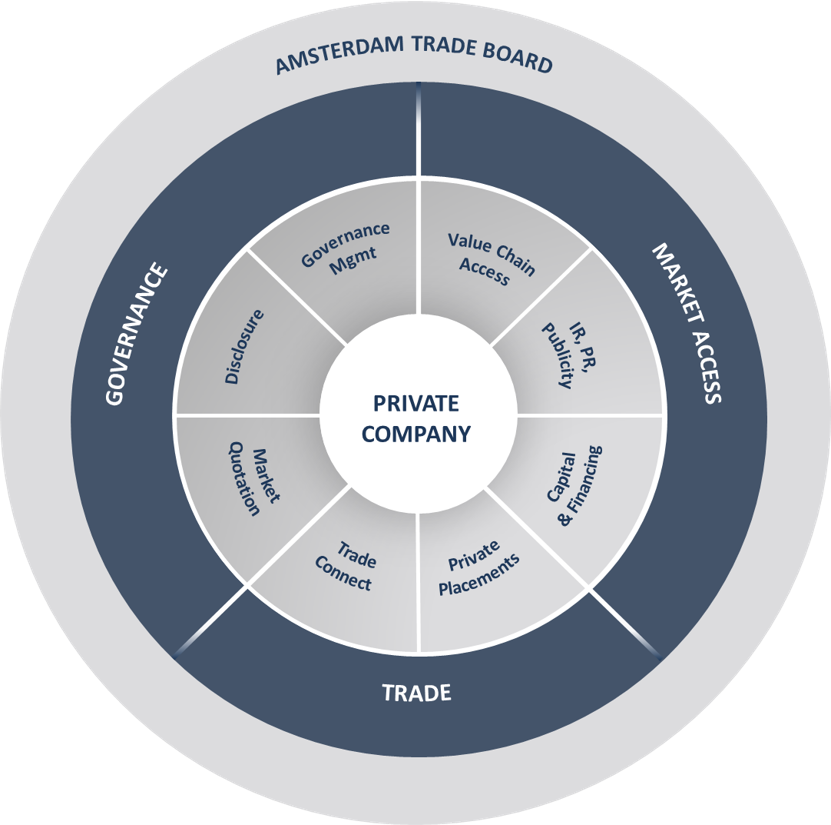Listing on ATB
An Integrated Governance Board
Why ATB governance board?
ATB is specifically designed as a private listing board where companies are subject to ATB governance rules and oversight. ATB listing provides companies with market access, governance tools, and European business and finance networks.
- Governance management
- Strategic growth and sales channels
- Networks and market visibility
ATB supports growth-oriented companies in their access to markets. Listed companies benefit from value enhancing advantages when managed and governed properly, including higher level of transparency, recognition, independent oversight, network, market access, price discovery, pull effect for business partners, employee attraction, corporate publicity.
Governance board allows listed companies to focus on value creating listing functions while retaining their private status and harvesting benefits from listing on the grounds of virtue signaling qualities and recognitions.

ATB Governance
Best Practices to Support SMEs and Growth-Oriented Companies
Governance tools for private markets
- Credibility and transparency
ATB implements the standards for credibility and transparency for SMEs in light of the constraints to corporate development due to higher levels of opaqueness and information asymmetries. - Valuation reference
ATB assigns the basis for the valuation reference, which establishes the connection with fundamentals, corporate value drivers and corporate currency that may be applied for strategic corporation actions and initiatives. - Economies of scale in private markets
ATB governance board creates economies of scale in information production, validation, communication, information dissemination, coordination with stakeholders, performance of fiduciary duties, and other governance functions.
Sample
ATB Effect
Trading Partners, Investors, Thought Leaders and Government Agencies
Companies listed on ATB signal their commitment to good governance. ATB validates and oversees the standing of its member companies thereby create opportunities for growth, financing, and value creation. ATB companies retain private status. Governance board separates governance functions from financial transactions that would otherwise trigger high sunk costs, strict compliance issues and responsibilities, and potentially negative effects.
ATB Effect
- Positive image for companies adhering to good governance
- Enhanced relationships, strengthened brand awareness and supplementary touch-points with both existing and new customers
- A constant presence in local and international markets
- Developing a positive image for international cooperation
- Long-term engagement with key clients
- Material valuation effect
- Corporate currency reference
- Transparent stakeholder management


Regulatory Status
Private Listing Board for Governance
ATB is designed as a governance and information listing board focused strictly on governance and information functions. ATB does not perform any regulated activities, such as those of a securities exchange, fundraising or trading venue. ATB facilitates access to capital, strictly outside of ATB, performed by affiliated licensed and regulated entities as private placement transactions. None of the ATB services constitute any regulated or financial activity.
ATB is suitable for companies with a long-view that wish to first establish its reputation before launching a fundraising campaign which typically leads to significantly more favorable financing terms on the basis of higher transparency, lower risk/uncertainty, and higher level of corporate and managerial capacity. ATB listing provides the company with visible track-record, documented delivery on strategic development goals, and continuing good-standing with ATB standards.
In terms of financial transaction execution, ATB listing is beneficial in providing single information disclosure and validation point for all stakeholders and a pricing reference, creating economies of scale for functions that would otherwise require overlapping information and due diligence review for multiple stakeholders.
